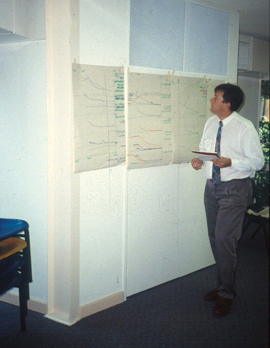|

Historical profiles.
|
The initial participatory analysis of the problem provides a sound basis for identifying the major factors that need to be investigated further if practical improvements in weed management are to be achieved. This sets an agreed context in which the
overall strategy can be designed. Thus, at the end of the workshop, a clear statement of the problem can be made, the most likely means of achieving improved weed management identified, and recommendations developed on the research, extension, training, and policy actions required to increase the chances of successful weed management being achieved.
In the parthenium workshop, historical profiles were used in the initial problem specification phase, to help understand the major factors that have influenced the problem to date and how these factors have changed over the past ten or twenty years. This not only helped all the group to understand the complex of factors surrounding the particular problem but also provided a basis for thinking about the changes that are likely to happen in the next three to five years that will have an influence on the options and the feasibility of improved weed management in the future.
|
The following are the main points arising from the parthenium historical
profiles:
 |
The area infested by parthenium increased markedly during the wet years of
1975-76. Future spread will be limited by suitable soil types and climate.
|
 |
The major factors considered to have affected the rate of spread were stocking pressure, seasons, recognition of and subsequent response to the problem, biological control, floods, land clearing, farming, landholder cash flow/ terms of trade, exploration and infrastructure development.
|
 |
Changes in land use have influenced the problem status of
parthenium.
|
 |
Parthenium has been spread by:
 |
movement of machinery and vehicles; |
 |
stock movement, particularly for agistment during drought; |
 |
stock feed; and |
 |
contaminated seed.
|
|
 |
As parthenium spreads into urban coastal areas, human health
problems (respiratory and dermatitis) will increase.
|
 |
Government funding for parthenium control is likely to be restricted in future.
|
 |
Stocking rates and income have been reduced because of
parthenium. |
|
|
|

